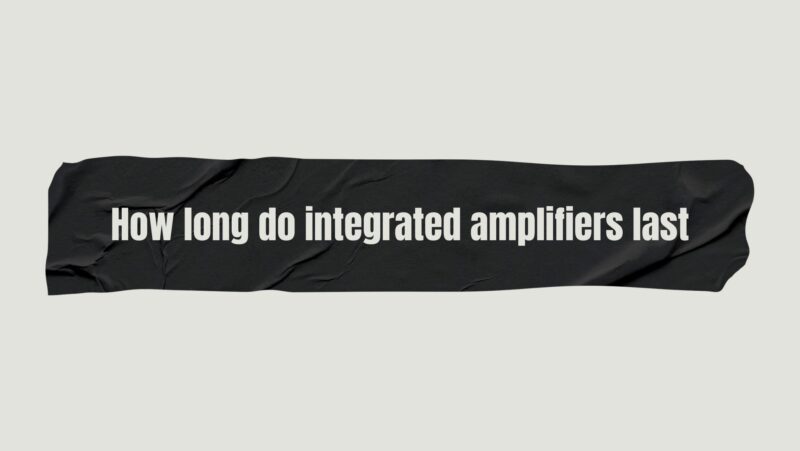Integrated amplifiers play a pivotal role in the realm of audio equipment, serving as the heart of audio systems by combining preamplification and power amplification functions. Enthusiasts and professionals alike invest in high-quality integrated amplifiers to elevate their audio experiences. As these amplifiers often come at a significant cost, understanding their lifespan and factors influencing longevity becomes crucial. In this in-depth article, we delve into the topic of how long integrated amplifiers last, explore the variables that impact their lifespan, and provide insights into effective maintenance practices to maximize their longevity.
Unveiling the Lifespan of Integrated Amplifiers
Integrated amplifiers, like many electronic devices, do not have a fixed expiration date. Their lifespan can vary widely depending on several factors. While some integrated amplifiers can last a few decades, others might face performance issues sooner. Generally, high-quality integrated amplifiers can be expected to last anywhere from 10 to 30 years or more with proper care and maintenance.
Factors Influencing Integrated Amplifier Lifespan
- Build Quality: The construction and component quality of an integrated amplifier significantly impact its longevity. Amplifiers built with durable materials, meticulous craftsmanship, and high-quality components tend to have longer lifespans.
- Usage Patterns: How often and how intensively an integrated amplifier is used plays a vital role in its lifespan. Frequent high-volume usage can cause components to degrade faster compared to more conservative usage.
- Heat Dissipation: Heat is a primary factor affecting electronic components. Integrated amplifiers with efficient heat dissipation mechanisms tend to have a longer lifespan as heat stress is reduced.
- Power Supply Quality: The stability and quality of the power supply directly affect an amplifier’s performance and longevity. Fluctuations in power can stress components and lead to premature failure.
- Environmental Conditions: Integrated amplifiers placed in dusty, humid, or excessively hot environments are more likely to suffer from performance issues and premature failure. Adequate ventilation and climate control are essential.
- Maintenance Practices: Regular maintenance, such as cleaning internal components and ensuring proper ventilation, can significantly extend the lifespan of an integrated amplifier.
Common Issues and Repairs
- Component Degradation: Over time, capacitors, resistors, and other internal components can degrade, leading to reduced audio quality and overall performance.
- Intermittent Connections: Frequent plugging and unplugging of cables can lead to loose connections, resulting in audio dropouts and other issues.
- Noise and Distortion: As components age, they may introduce noise, distortion, or unwanted artifacts into the audio signal.
- Overheating: Inadequate ventilation or prolonged high-volume usage can cause integrated amplifiers to overheat, potentially damaging internal components.
Effective Maintenance Practices
- Proper Ventilation: Ensure that integrated amplifiers have sufficient space for proper airflow to dissipate heat effectively.
- Conservative Usage: Avoid running integrated amplifiers at maximum volume for extended periods. Use them within their recommended power ratings to reduce strain on components.
- Regular Cleaning: Dust and debris can accumulate inside amplifiers, impacting their performance. Periodically clean the interior and vents to maintain optimal airflow.
- Voltage Regulation: Use voltage regulators or power conditioners to protect integrated amplifiers from power fluctuations and electrical surges.
- Cooling Fans: If integrated amplifiers are not equipped with internal cooling fans, consider adding an external fan to help regulate temperature.
- Surge Protection: Connect integrated amplifiers to surge protectors to safeguard against power surges and voltage spikes.
- Professional Maintenance: Periodically have integrated amplifiers inspected by a professional technician. They can identify potential issues before they escalate.
Balancing Performance and Longevity
- Technology Advancements: Advancements in amplifier technology continue to improve efficiency, reliability, and performance. Newer integrated amplifiers might offer better longevity compared to older models.
- Upgrade Considerations: As technology evolves, users might opt to upgrade their integrated amplifiers to take advantage of improved performance and features.
Conclusion
The lifespan of integrated amplifiers is influenced by a myriad of factors, from build quality and usage patterns to maintenance practices and environmental conditions. As with any high-end audio equipment, investing in a reputable integrated amplifier and following proper maintenance practices can significantly impact performance and longevity. By understanding the intricacies of integrated amplifier lifespan and taking proactive steps to mitigate potential issues, audio enthusiasts and professionals can enjoy optimal sound quality and extended use from their amplification systems.


